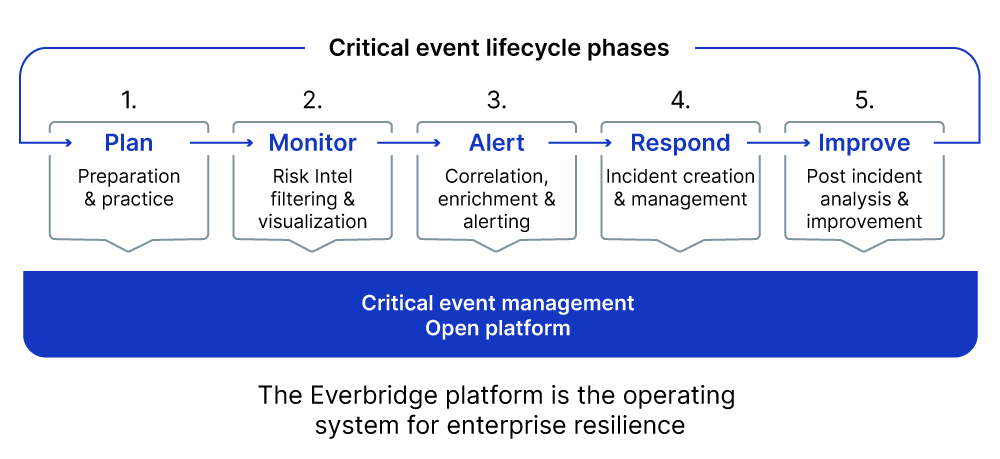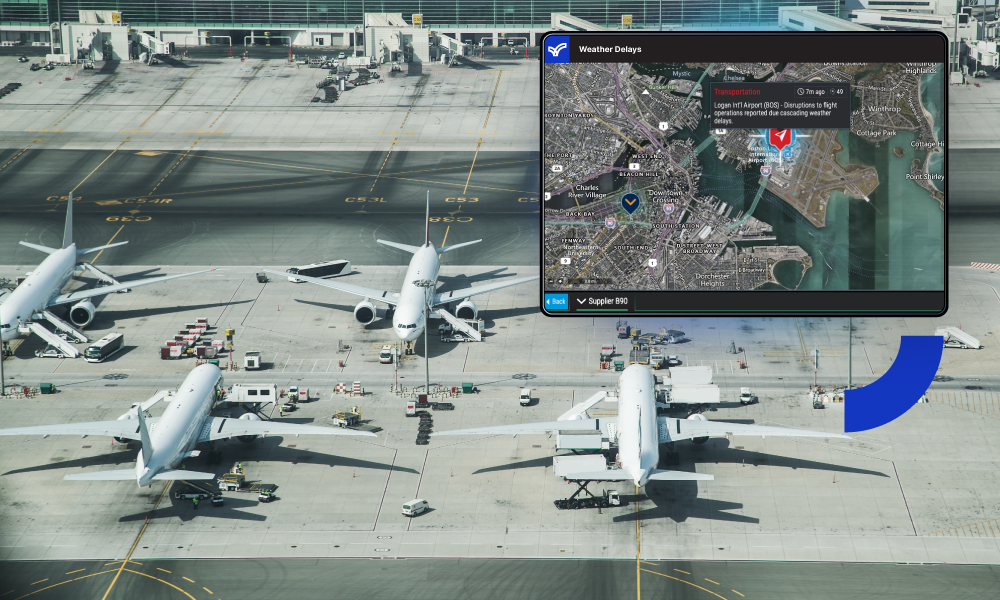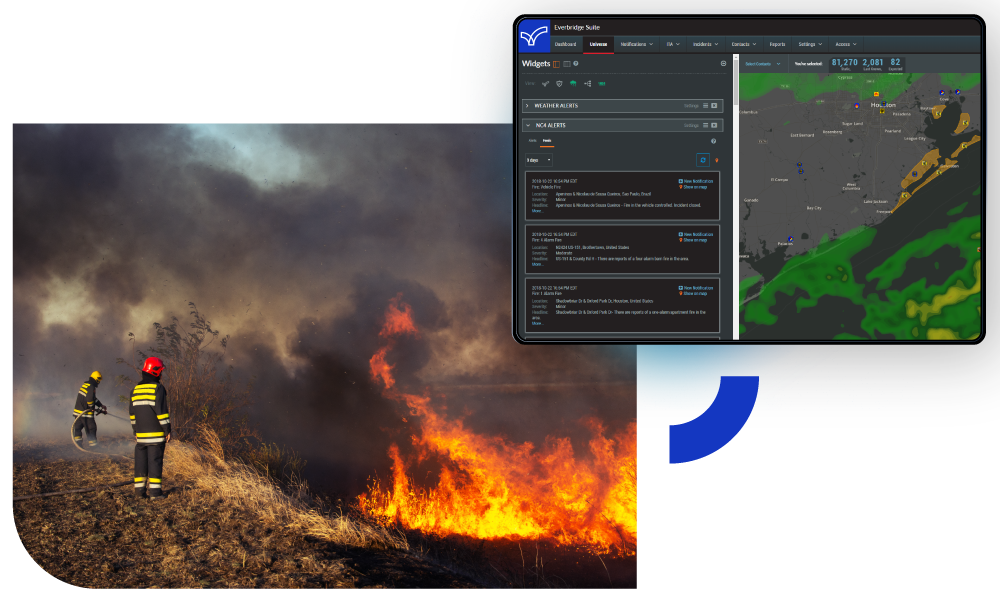The value of business continuity as part of your end-to-end critical event management strategy
In today’s volatile business environment, organizations face a mountain of unpredictable challenges—from natural disasters to cyber-attacks, supply chain disruptions to IT outages—that can impact the safety of employees, operational uptime, or customer satisfaction and loyalty. The ability to navigate these critical events hinges on one key factor: resilience. Here, we explore why business continuity is essential to your end-to-end critical event management strategy and how comprehensive planning and preparedness can redefine organizational resilience.
Why business continuity is vital today
Effective business continuity solutions are no longer optional; they are critical. The landscape we operate in is fraught with unpredictability. The frequency and severity of disruptions have escalated, making robust preparation and rapid response mechanisms a necessity. Furthermore, regulatory compliance demands have tightened, with many industries now subject to stringent regulations that require detailed continuity and disaster recovery plans.
Customer trust and loyalty also hinge on the reliability of an organization’s continuity plans. During crises, the ability to maintain service delivery can make the difference between retaining and losing valuable customers. From a financial perspective, minimizing downtime and ensuring that operations continue smoothly during disruptions can stave off significant financial losses, preserving your organization’s stability and reputation.
The comprehensive approach of an end-to-end solution
Organizational resilience requires a robust end-to-end critical event management strategy that incorporates business continuity. The lifecycle of managing a critical event is built on five foundational pillars: Plan, Monitor, Alert, Respond, and Improve. These pillars ensure that organizations are not only prepared for any event but can also respond effectively, recover swiftly, and continuously enhance their resilience strategies.
The Everbridge platform

The key capabilities of an effective business continuity solution include the ability to develop detailed, tailored plans that address specific organizational needs. Conducting thorough business impact analyses is crucial for identifying and prioritizing critical business processes and resources. Equally important is fostering enterprise-wide collaboration, enabling teams to work together seamlessly across the organization.
Regular testing and refinement of continuity plans are essential to ensure their effectiveness. Meeting industry-specific compliance requirements effortlessly is another critical capability, allowing organizations to navigate regulatory landscapes with confidence.
The value of a comprehensive solution
An all-in-one end-to-end platform is designed to ensure that organizations can anticipate, mitigate, respond to, and recover from critical events. Such a platform integrates business continuity planning with critical event management, creating a cohesive and unified approach. Enhanced communication capabilities accelerate the dissemination of critical information and facilitate collaboration across the enterprise, significantly reducing response times during crises.
Streamlined onboarding processes enable new users to quickly and fully leverage the platform’s capabilities, ensuring that the organization can benefit from the solution’s full potential from the outset. Minimizing communication errors during crises enhances the accuracy and reliability of information, which is crucial for effective incident management.
Continuous improvement is a fundamental aspect of a comprehensive solution. By using real-time data and feedback, organizations can refine and enhance their response strategies, ensuring that they are always prepared for the next challenge
Conclusion
In the face of today’s complex threat landscape, having business continuity as part of your end-to-end enterprise resilience strategy is not just beneficial—it’s essential. A comprehensive end-to-end solution provides the resilience organizations need to stay prepared and responsive. By effectively planning, anticipating, and responding to critical events, organizations can not only survive disruptions but emerge stronger.
Achieve total enterprise resilience with a robust business continuity solution—keeping your people safe and your operations running, no matter what challenges arise.
To learn more or to request a demo of how Everbridge 360 – now with Infinite Blue – can help you achieve total enterprise resilience…..
Threats and disruptions of all types are increasing, a higher frequency equates to a bigger impact on populations and businesses
The Best in Resilience Certification affirms your organization’s readiness to manage any critical event that impacts organizations, assets, and resources.
By Sean McDevitt, Director of CEM Product Marketing at Everbridge
As climate change continues to pose significant risks to organizations worldwide, it’s not only the physical threats of extreme weather events that companies must navigate but also an evolving landscape of regulatory requirements. The U.S. Securities and Exchange Commission (SEC) has introduced climate disclosure rules requiring publicly traded companies to provide detailed reporting on how climate change affects their business, both in terms of actual and potential impacts. This regulatory shift underscores the need for a robust, real-time response and risk management system like Everbridge Critical Event Management (CEM), designed to help organizations assess, act upon, and analyze climate-related risks efficiently and effectively.
Understanding the risk and regulatory landscape
The introduction of SEC climate disclosure rules marks a significant step towards transparency and accountability in how organizations address climate change. These rules compel organizations to evaluate not just the immediate physical risks posed by climate events but also the broader implications on their operations, financial performance, and strategic outlook. Everbridge CEM provides an essential toolset for navigating both these dimensions, offering advanced capabilities to assess climate risks and the means to report on these risks in compliance with regulatory requirements.
Real-time assessment and compliance alerts
Everbridge CEM’s real-time monitoring and alert system is pivotal for organizations striving to stay ahead of both climate events and regulatory changes. By offering tailored alerts on climate-related risks and regulatory updates, Everbridge ensures that organizations can respond promptly to physical threats while also keeping pace with compliance requirements, integrating this data with actionable insights for both immediate response and long-term strategy adjustments.
Actionable insights for immediate response and reporting
Swift action in the face of climate events is critical, but so is the ability to document and report these actions in alignment with SEC disclosures. Everbridge CEM facilitates this dual need by enabling organizations to not only coordinate efficient response efforts but also track and document these actions in a manner that aligns with disclosure requirements. This capability ensures that companies can provide transparent reporting on their risk management processes and outcomes, an essential component of compliance.

Enhancing coordination for compliance
The coordination capabilities of Everbridge CEM extend beyond managing physical climate events to facilitating compliance with regulatory requirements. By enabling seamless communication and information sharing across departments, Everbridge helps ensure that all aspects of climate risk management, from initial risk assessment to final reporting, are conducted in a comprehensive and compliant manner. This holistic approach is vital for meeting SEC requirements and for fostering investor confidence.
Analyzing and learning from events for regulatory reporting
Post-event analysis is crucial not just for internal improvement but also for regulatory compliance. Everbridge CEM’s comprehensive reporting and analysis tools allow organizations to meticulously review their handling of climate events, providing the data needed for SEC climate disclosures. This includes detailing the efficacy of response measures, the financial implications of climate events, and the steps taken to mitigate future risks.

Continuous improvement through regulatory insight
The analytics capabilities of Everbridge CEM offer a pathway for continuous improvement, not only in risk management practices but also in compliance and reporting. By utilizing data from past events, organizations can refine their strategies to meet both operational and regulatory needs more effectively. This ongoing cycle of analysis and adaptation is key to thriving in a regulatory environment focused on transparency and accountability in climate risk management.
The SEC climate disclosure rules represent a paradigm shift in how organizations approach climate risk management, placing a premium on transparency, accountability, and strategic foresight. Everbridge Critical Event Management emerges as a comprehensive solution in this new landscape, enabling organizations to not only manage the physical risks of climate change effectively but also navigate the complexities of regulatory compliance. With Everbridge CEM, organizations have a powerful ally in their efforts to protect their operations, meet investor and regulatory expectations, and contribute to a sustainable future.